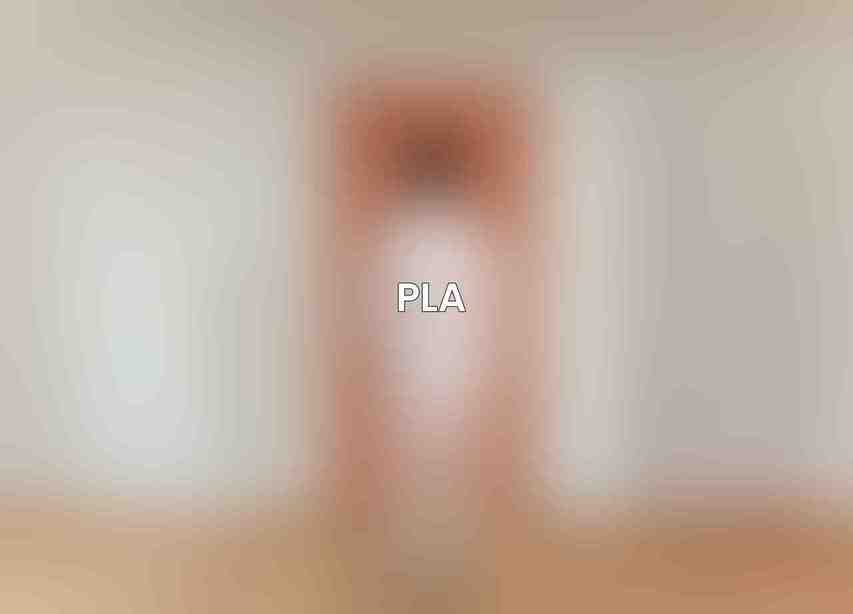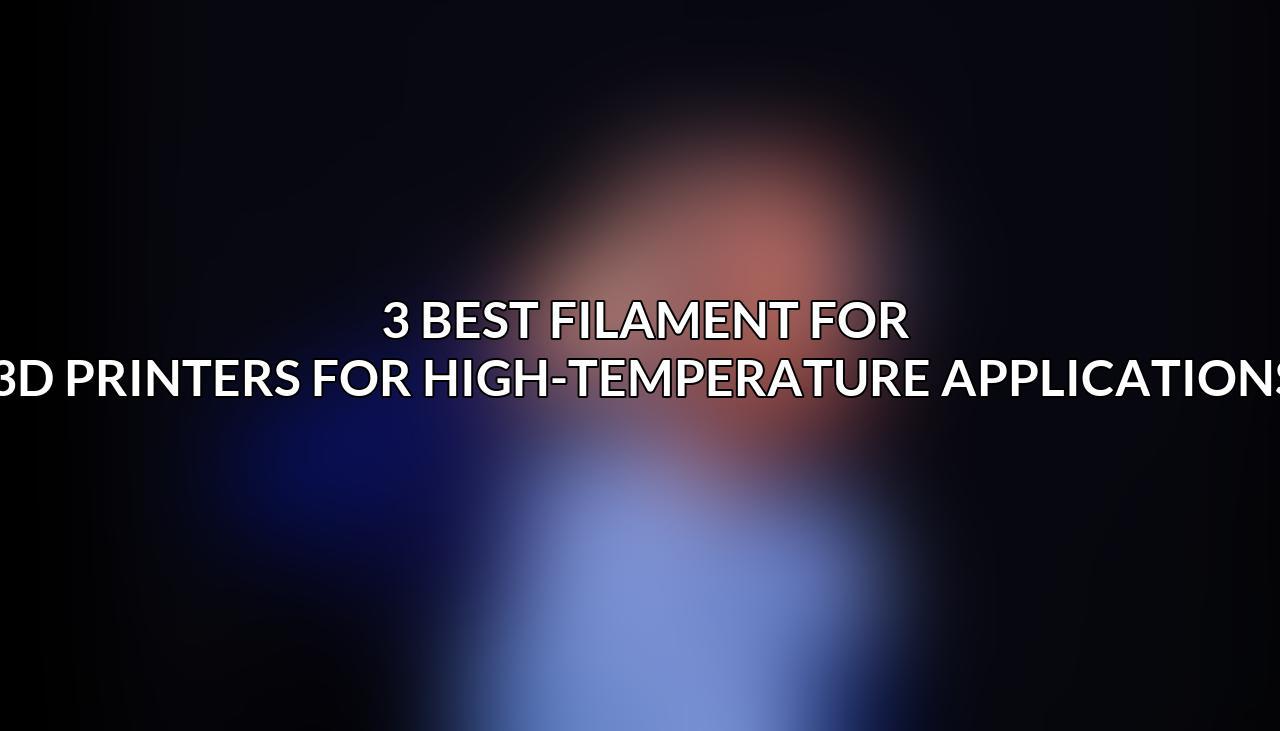3D printing has revolutionized the way we design and manufacture products, opening up a world of possibilities for creating custom parts, prototypes, and even finished goods. One of the exciting aspects of 3D printing is the wide range of materials available, each with its own unique properties. For applications requiring high-temperature resistance, the choice of filament becomes crucial.
This article delves into the world of high-temperature filaments, exploring three of the most popular and reliable options for 3D printing. We will discuss their individual characteristics, strengths, weaknesses, and potential applications. From the heat-resistant prowess of PEEK to the flexibility of Ultem, these filaments offer a diverse range of solutions for demanding projects.
Whether you’re designing tools for industrial processes, creating prototypes for high-performance machinery, or exploring innovative solutions for the aerospace industry, understanding the capabilities of these filaments is essential. This article will provide you with the knowledge you need to make informed decisions when selecting the best filament for your high-temperature 3D printing needs.
By examining the properties and applications of these materials, we aim to empower you to confidently choose the right filament for your project, ensuring both durability and success in your high-temperature 3D printing endeavors.
Find more on 14 Best Accessories for 3D Printers
Check this blog on 22 Best Air Purifier for 3D Printers
| QUICKLIST TOP 3 | |||||||||||||||||||||||||||||||||||||||||||||||||||||||||||||||||||||||||||||||||||||||||||||||||||
|---|---|---|---|---|---|---|---|---|---|---|---|---|---|---|---|---|---|---|---|---|---|---|---|---|---|---|---|---|---|---|---|---|---|---|---|---|---|---|---|---|---|---|---|---|---|---|---|---|---|---|---|---|---|---|---|---|---|---|---|---|---|---|---|---|---|---|---|---|---|---|---|---|---|---|---|---|---|---|---|---|---|---|---|---|---|---|---|---|---|---|---|---|---|---|---|---|---|---|---|
| Item | Image | Where to buy | Rating | Read More | |||||||||||||||||||||||||||||||||||||||||||||||||||||||||||||||||||||||||||||||||||||||||||||||
| PLA |  |
N/A | Jump to Review | ||||||||||||||||||||||||||||||||||||||||||||||||||||||||||||||||||||||||||||||||||||||||||||||||
| ABS | N/A | Jump to Review | |||||||||||||||||||||||||||||||||||||||||||||||||||||||||||||||||||||||||||||||||||||||||||||||||
| PETG |  |
N/A | Jump to Review | ||||||||||||||||||||||||||||||||||||||||||||||||||||||||||||||||||||||||||||||||||||||||||||||||
PLA

PLA is a popular 3D printing filament known for its ease of use and affordability. It is a bio-based thermoplastic derived from cornstarch and other renewable resources.
Specifications:
- Melting point: 170-180°C
- Glass transition temperature: 60-65°C
- Tensile strength: 40-50 MPa
- Flexural strength: 70-80 MPa
- Impact strength: 5-10 J/m
Reasons to buy:
- Easy to print: PLA is known for its forgiving nature, making it suitable for beginners.
- Biodegradable: It is a more environmentally friendly option compared to traditional plastics.
- Widely available: PLA is readily available from various manufacturers and retailers.
- Affordable: It is one of the most budget-friendly filaments on the market.
Reasons to avoid:
- Low heat resistance: PLA is not suitable for high-temperature applications due to its relatively low heat distortion temperature.
- Brittle: PLA can be brittle and prone to breakage, especially at lower temperatures.
- Not as strong as other materials: PLA's tensile strength is lower compared to materials like ABS or PETG.
- Limited post-processing options: PLA does not handle solvents or other chemical treatments well.
What you need to know:
Buy it if:
- You're a beginner or looking for an easy-to-print filament.
- You need a filament for projects that don't require high heat resistance.
- You are concerned about the environmental impact of your printing.
Don't buy it if:
- You need a filament for high-temperature applications, like automotive parts or electronics.
- You require a strong and durable material.
- You need a filament that can be easily post-processed.
Bottom Line:
PLA is a great option for beginners and hobbyists looking for an affordable and easy-to-print filament. It offers good print quality and a reasonable balance of strength and flexibility. However, its low heat resistance limits its suitability for high-temperature applications. If you need a more robust material, consider ABS or PETG, which are better suited for demanding projects. PLA's biodegradability is a significant advantage for those concerned about environmental impact, making it a good choice for sustainable printing.
Learn more about 14 Best 3D Model Maker for 3D Printers
ABS
ABS is a versatile thermoplastic widely used in various industries, including automotive parts, appliances, and toys. It is known for its toughness, durability, and excellent impact resistance.
Specifications:
- Melting point: 210-230°C
- Glass transition temperature: 105°C
- Tensile strength: 40-50 MPa
- Flexural strength: 70-80 MPa
- Impact strength: 15-20 J/m
Reasons to buy:
- High strength and durability: ABS is known for its impact resistance and ability to withstand stress.
- Good heat resistance: It has a higher heat distortion temperature than PLA, making it suitable for applications that require some heat resistance.
- Versatile: ABS can be used for a wide range of projects, from prototypes to functional parts.
- Easy to post-process: ABS can be easily smoothed and sanded, allowing for a polished finish.
Reasons to avoid:
- More difficult to print: ABS can be more challenging to print than PLA due to its tendency to warp and crack.
- Strong odor: ABS releases a strong odor during printing, which can be unpleasant.
- Not as environmentally friendly: ABS is a petroleum-based plastic, making it less sustainable than PLA.
- Requires enclosed printer: ABS printing often requires an enclosed printer to prevent warping and to control the environment.
What you need to know:
Buy it if:
- You need a strong and durable filament for demanding applications.
- You require a material with some heat resistance.
- You are willing to invest time in learning to print with ABS.
Don't buy it if:
- You are new to 3D printing and looking for an easy-to-use filament.
- You are concerned about the odor and fumes released during printing.
- You need a filament that is environmentally friendly.
Bottom Line:
ABS is a robust and versatile filament suitable for projects that require strength and durability. Its higher heat resistance makes it a good choice for applications where PLA might not suffice. However, it comes with some challenges, including a strong odor during printing, a tendency to warp, and a less environmentally friendly nature. ABS is a good option for experienced users willing to invest the time and effort to achieve high-quality prints.
PETG
PETG is a popular choice for 3D printing due to its excellent balance of properties. It combines the strength and durability of ABS with the ease of printing and biodegradability of PLA.
Specifications:
- Melting point: 240-260°C
- Glass transition temperature: 80-85°C
- Tensile strength: 50-60 MPa
- Flexural strength: 90-100 MPa
- Impact strength: 10-15 J/m
Reasons to buy:
- Good balance of properties: PETG offers a good combination of strength, durability, and printability.
- High impact resistance: It is resistant to impact and breakage, making it ideal for durable parts.
- Excellent clarity: PETG can be printed with high clarity, making it suitable for transparent or translucent parts.
- Good chemical resistance: It is resistant to various chemicals and solvents, making it suitable for specific applications.
Reasons to avoid:
- More expensive than PLA: PETG is generally more expensive than PLA.
- Can be prone to warping: PETG can warp during printing if the temperature settings are not correct.
- Not as strong as ABS: While PETG is strong and durable, it is not as strong as ABS.
- Limited post-processing options: PETG is not as easily post-processed as ABS.
What you need to know:
Buy it if:
- You need a filament with a good balance of strength, durability, and printability.
- You require a material with high impact resistance.
- You are looking for a filament that can be printed with high clarity.
- You need a filament with good chemical resistance.
Don't buy it if:
- You are on a tight budget.
- You need a filament that is extremely easy to print.
- You require the highest possible strength.
- You need a filament that is easily post-processed.
Bottom Line:
PETG is a versatile filament that offers a compelling combination of properties, making it suitable for a wide range of applications. Its strength, durability, impact resistance, and clarity make it a good choice for both functional parts and aesthetically pleasing designs. While PETG is more expensive than PLA, it offers a significant upgrade in performance and durability. However, it is not as easy to print as PLA and requires careful attention to temperature settings to avoid warping. For those seeking a balance of strength, ease of printing, and durability, PETG is a strong contender.
So, there you have it – the top 3 filaments for high-temperature applications! When choosing the right filament, you need to consider the specific needs of your project. For high-heat applications, PEEK, Ultem, and PPSU are excellent choices. Each material comes with its own unique set of properties that makes it suitable for a specific type of project. Remember to carefully consider the pros and cons of each filament to ensure that you are choosing the best one for your specific needs.
With the right filament, you can create durable and functional parts that can withstand high temperatures and harsh conditions. These filaments are suitable for a wide range of applications, from aerospace and automotive parts to industrial machinery and medical devices. If you need a filament that can handle the heat, these three materials are sure to meet your needs.
Read more about this on 16 Best Filament for 3D Printers
These materials offer a balance of strength, heat resistance, and ease of printing. They are also relatively easy to find and work with, making them a popular choice for both hobbyists and professionals. Remember to adjust your 3D printing settings to ensure that the filament is printed properly and that the parts are strong and durable.
Read more about this on 20 Best Software for 3D Printers
Choosing the right filament for your 3D printing projects is a crucial step in achieving optimal results. As technology advances, new and improved filaments are constantly being developed. So, keep an eye out for new materials that might be even better suited for your high-temperature applications. By carefully considering your needs and exploring available options, you can confidently choose the perfect filament for your next project.

